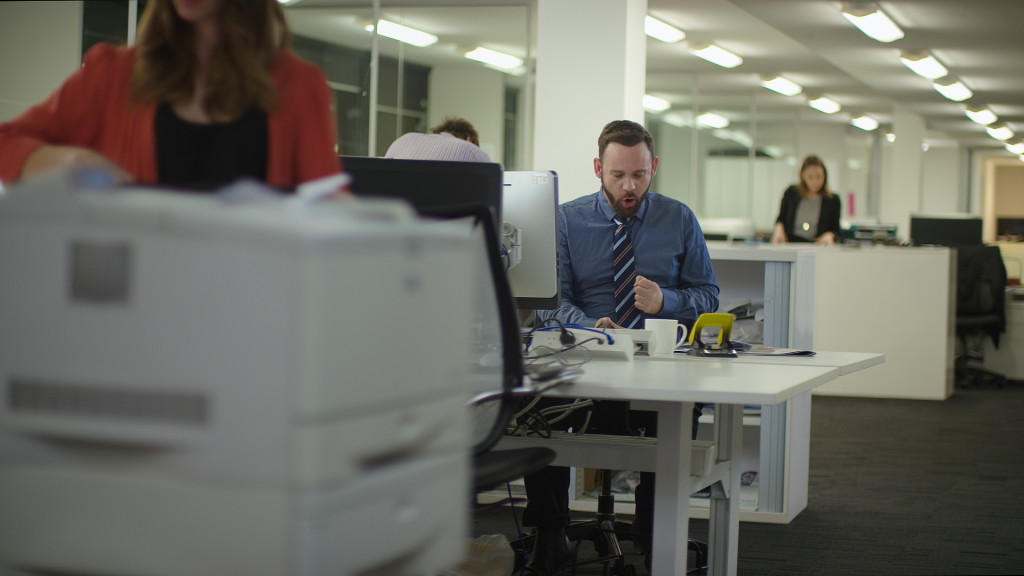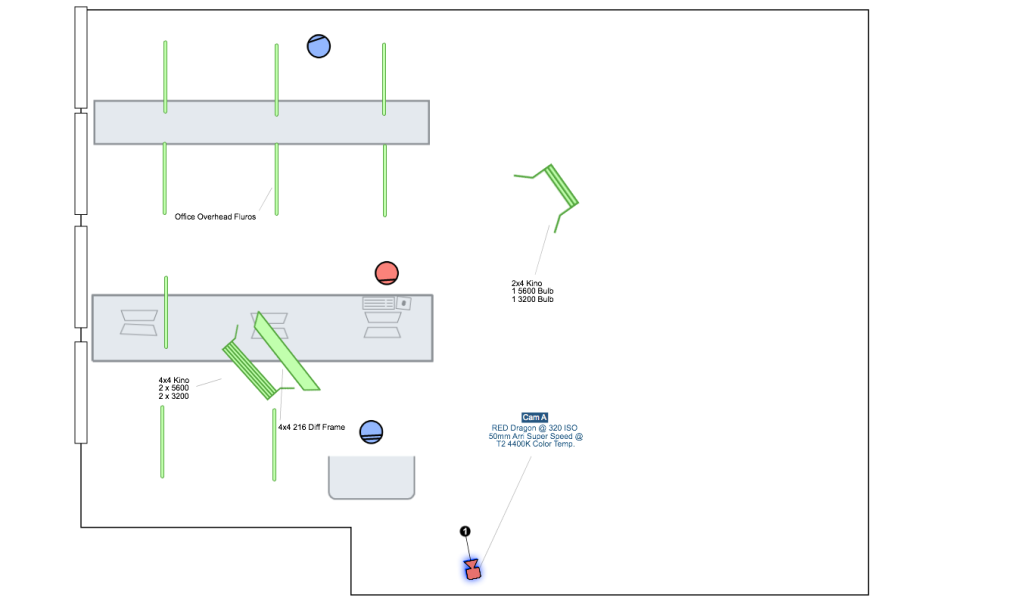Subscribe to the Podcast:
Show Notes
In this episode of The Wandering DP Podcast we continue our break down of a recent commercial I shot on the RED Dragon paired with Arri Zeiss Super Speeds.
This commercial was unique in that we were limited to house power for our lighting set ups which means we had to choose our angles and locations wisely.
Below are images of the lighting set ups discussed in this podcast along with the images that coincide with the diagrams.
The Office
Time of Day: 6:00PM (winter)
Keys to Success:
The hardest part here was going to be matching the color of the fluorescent overheads in the office with the limited resources we had. The fluros have a unique color temperature and a wider variance from unit to unit when compared to a kino flo.
The solution was to disable the fluros that were near the talent and use our kinos with a checkerboard set up. 2 x daylight bulbs, 2 x tungsten bulbs.
When we moved in for the CUs we added blacks to shape the light that was already there.
Thanks for Listening
Thanks again for listening to the show. If you find the content valuable please share the podcast using the social media buttons on this page.
Also, reviews for the podcast on itunes are extremely helpful for the getting the word out about the show. If you can take a second to write an honest review that would be greatly appreciated. The more reviews the more people the show can reach and I do take on board all the comments to try and make the show as good as possible.
And lastly, don’t forget to subscribe on Itunes or Stitcher to make sure you are always up to date with the latest episodes from the podcast or even better, sign up to The Wandering DP Newsletter to get automatic updates on new podcasts as well as blog posts and exclusive downloads. To join click the link below.




Hey Patrick.
Thanks so much for all your work. I’ve been listening to your podcast since first episode.
I was blown away by your work on UWA commercial. Hope you will make episode about that commercial in the future.
Thanks Evgeniy!
The UWA commercial will be a whole series shortly. Everything from pre-production to post production.
first thing first, thank you so much for the work and effort you put in all the podcasts, lessons and the interviews, would it be too much to ask if you can share what way you would have lit same scenarios if you would have access to bigger lights and crew, again thanx.
Hey Patrick, really love your shows and I’ve been listening to all of them for a long time. Thank you for your dedication to making the show! I’m a senior visual effects artist who’s trying to work my way into the cinematography/director world, so in this area I’m quite a new guy.
I have a question which I’ve been wanting to ask you for quite a while, it occurred to me when you said the inverse square law of light attenuation. The question is, what’s the difference between high power/luminance lighting vs low power/luminance lighting? Why do you choose high power one?
Say now I have 2 sets of lightings, the first one is made of some 1k lights and the second one is made of some 12k lights. Their ratios and quality is exactly the same, the only difference is the luminance. Would I be able to use ASA on camera or ND filters or whatever way to match their levels to get almost the same looks? Put it in another way, does the power of lights affect things apart from exposure in a perfectly controlled lighting environment?
Thanks a lot!
-Tron
Hypothetically I don’t care about the noise that comes with high ASA.
Hi Tron,
The big difference is the quality of light.
You have to have a big source to make something soft. If you want to make a whole room soft with light coming from the window and you bounce a 1k into it you will have enough soft exposure for someone standing 1 foot from the window. If you want a wide of a big room and you want it all soft and at the same exposure then you need to make the source giant, back it up so the inverse square law covers you over the distance inside the frame, then go for gold.
To do that you need a big light. Big lights are the hollywood look. Unfortunately there is no way around it.
Hey Patrick,
I’ve been following you from the first Podcast. Thank you for the effort and dedication to get all this out on the public domain! Really helpful! Waiting for the UWA commercial breakdown…
If you could shed some light on the flut control on the dragon, and the different ASA ratings you could manipulate for both the skintone highlight olpf and the lowlight olpf, that would be great.
Once again, thanks!
Hey Patrick,
Like a lot of readers I’ve been following your podcast from day 01 and I’m a huge fan. I wanted to get your take on the darker image you and a lot of DP’s seem to favor. What is it about the darker image do you like so much? It seems to be a trend that’s very popular right now on vimeo. Honestly I am a fan of it myself and I can’t put my finger on exactly why, but I haven’t yet been hired to shoot a commercial with that darker mood. Clients seem to like nice bright images.
What I’ve found though is that people who view some of my darker stuff on mobile devices that have that auto-brightness setting on tend to tell me that it’s too dark, they can’t see the content very well. I’m wondering if people looking to hire me may be watching my work on mobile devices and may be avoiding hiring me due to seemingly under-exposed images? Have you had any experience with this? With mobile getting so popular are we potentially doing ourselves a disservice as cinematographers by not being able to control the brightness levels on another’s device?
Thanks for everything you do with your blog, love your work.
Best,
Matt